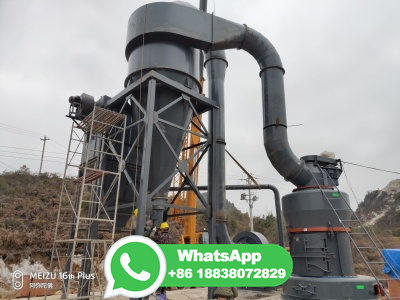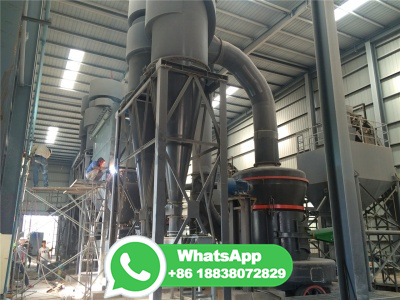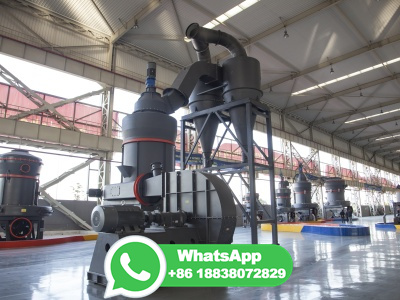
In most cases, arsenic is an unfavorable element in metallurgical processes. The mechanism of arsenic removal was investigated through roasting experiments performed on arsenopyritebearing iron ore.
WhatsApp: +86 18203695377
To study the interaction between iron ore and magnesium additives, several types of interaction couples were prepared and SEMEDS was used to measure the diffusion distance of Mg 2+.Results showed that prolonging the roasting time was beneficial to the diffusion of Mg 2+ in the iron ore. When the basicity (CaO/SiO 2) of iron ore increased from to, the diffusion distance of Mg 2 ...
WhatsApp: +86 18203695377
Calcination Roasting Process. The usual method of process and treatment of the calcines (by calcination) from the roasting of gold ores is to cool in air, quench the moderately cooled material in water, and subject it to a light grind with pebbles or balls to break up agglomerated particles, sintered prills, etc.
WhatsApp: +86 18203695377
The mineralogical and chemical changes in Chinese Xinjiang iron ore containing impurities, lead, and zinc as a result of reduction roasting were studied via chemical analysis, optical microscopy, Xray fluorescence (XRF), electron probe microanalysis (EPMA), and energydispersive spectroscopy (EDS). Analysis showed that hematite was the main ironbearing mineral, with small amounts of ...
WhatsApp: +86 18203695377
The results showed that the lowgrade iron ore could be upgraded from 56 to % Fe with a yield of % at a roasting temperature of 750 °C, a roasting time of 45 min, a kiln rotational speed of 5 rpm, and a reductant dosage of 20%.
WhatsApp: +86 18203695377
The beneficiation of iron minerals and arsenicbearing minerals from arsenicbearing iron ores with a calcificationmagnetizing roasting and lowintensity magnetic separation (CMRLMS) process is investigated in this work. The results show that the process is successful in extracting iron minerals and eliminating arseniccontaining minerals.
WhatsApp: +86 18203695377
The reduced amounts of monazite and the lack of detection of the florencite phases indicated the decomposition of the phosphate phases during the sulfation roasting process. Iron was detected predominantly in oxide and alloy phases indicating minimal sulfation of this metal. The mineralogical analysis indicates selective sulfation of the REEs.
WhatsApp: +86 18203695377
This research is aimed at the upgradation of indigenous Pakistani iron ore,, Dilband iron ore (hematite), by utilizing common metallurgical processes. First, the magnetic properties of the ore were determined. Initially, the iron ore samples contained 34 wt. % Fe in addition to other gangue materials. Therefore, the ore was subjected to a hightemperature reduction roasting process ...
WhatsApp: +86 18203695377
The ore is scooped up and thrown directly into a container of water causing it to fracture and fragment into many small pieces. It is then shoveled onto a tarp where it will air dry for a couple of days. We find that when we roast our locally available hydrated ores (limonite, goethite) this method produces a very friable product that is ready ...
WhatsApp: +86 18203695377
The results of the flash roastingmagnetic separation process show that a mixed iron concentrate containing % Fe with an iron recovery of % would be achieved after selective grinding and ...
WhatsApp: +86 18203695377
Reduction roasting of manganese ores is a known process; however, it is not yet commercialized mainly due to various technoeconomic issues. The current research work presents results of a largescale plant trial performed at a commercial Direct Reduced Iron making plant to upgrade lowgrade ferruginous manganese ores (Mn: 2532%, Mn/Fe: ∼1).
WhatsApp: +86 18203695377
Roasting reactor performs stable production, with highquality roasted product. • Hematite and siderite were converted into magnetite, enhancing magnetism of iron ore. • Good performance both in technical and equipment. Abstract
WhatsApp: +86 18203695377
Moreover, the strong magnetic mineral metallic iron content in the roasted ore increases, but, when there is too much calcium chloride content, the excess volatile hydrogen chloride gas generated can lead to a reduction of metallic iron; by generating iron chloride, the roasting ore metal iron content is reduced. 29 Thus, the recovery rate of ...
WhatsApp: +86 18203695377
Iron ore grade in China is mainly 30%35% [9,10]. The quantity of mining is large, the mining cost is high, the economic benefits are low and it is easy to affect the environment. ... In the process of deep reduction roasting, the oxygen atoms of iron oxide gradually lose, and the oxygen atoms combine with the carbon atoms to form CO and .
WhatsApp: +86 18203695377
At present, magnetization roasting followed by magnetic separation is one of the most effective technologies for the beneficiation of refractory iron ores. However, in the process of magnetization roasting, a large amount of reductant is required.
WhatsApp: +86 18203695377
[1] Roasting consists of thermal gassolid reactions, which can include oxidation, reduction, chlorination, sulfation, and pyrohydrolysis. In roasting, the ore or ore concentrate is treated with very hot air. This process is generally applied to sulfide minerals.
WhatsApp: +86 18203695377
Keep the temperature low, unless you're planning to get the surface of the meat seared, forming a delectable crust. If so, start out at a high temperature for about 15 minutes and then reduce it. If you're using charcoal, bank the coals close to the meat for about 15 minutes then pull them back, away from the roast.
WhatsApp: +86 18203695377
The mineral composition in the roasted ores was characterized using XRD. The relationship between metallic iron particles and gangue and the occurrence of phosphorus in roasted ores were observed by SEMEDS, and the essential relationship between the separation of iron and phosphorus and the reduction of iron minerals was revealed. 3.
WhatsApp: +86 18203695377
The iron phase transition results of roasted iron ore can be summarized as FeOOH to αFe 2 O 3 to Fe 3 O 4. With increasing temperature, the iron content increases gradually, and the magnetism of limonite also increases, indicating that the magnetism of ... Subsequently, Rath et al. studied the reduction roasting process of iron ore mines ...
WhatsApp: +86 18203695377
The reduction of iron ore using biomassbased reductants has opened up a new chapter because of its contribution to energy conservation and emission reduction. In this connection, the application of waste coconut shells (CS) as the reductant in the reduction roastingmagnetic separation of an iron ore overburden sample is explored.
WhatsApp: +86 18203695377
Iron ores are the raw material used to make iron and steel. Iron ore production has significantly expanded in recent years, owing to increasing steel demands in developing countries, such as China. As the content of iron ore in deposits has deteriorated, lowgrade iron ore has been processed. ... During the roasting process of fluxed pellets in ...
WhatsApp: +86 18203695377
Magnetization roasting is one of the most effective way of utilizing lowgrade refractory iron ore. However, the reduction roasting of siderite (FeCO 3) generates weakly magnetic wüstite, thus reducing iron recovery via weak magnetic separation.
WhatsApp: +86 18203695377
Iron ore tailings have become one kind of the most hazardous solid waste. In order to recycle iron in the tailings, we present a technique using magnetizing roasting process followed by magnetic separation. After analysis of chemical composition and crystalline phase, according to experimental mechanism, the effects of different parameters on recovery efficiency of iron were carried out.
WhatsApp: +86 18203695377
The optimal conditions were determined to be a roasting time of min with a strawtype biomass dose of 20 wt% and a roasting temperature of 800 ℃, in which an iron grade of % and ...
WhatsApp: +86 18203695377